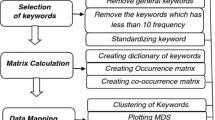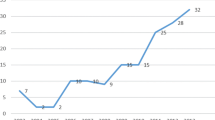Abstract
To analyse developments of scientific fields, scientometrics provides useful tools, provided one is prepared to take the content of scientific articles into account. Such cognitive scientometrics is illustrated by using as data a ten-year period of articles from a biotechnology core journal. After coding with key-words, the relations between articles are brought out by co-word analysis. Maps of the field are given, showing connections between areas and their change over time, and with respect to the institutions in which research is performed. In addition, other approaches are explored, including an indicator of ‘theoretical level’ of bodies of articles.
Similar content being viewed by others

Notes and references
Science dynamics studies are empirical investigation of the factors that determine developments in the sciences, not (only) out of general historical and intellectual interest, but (also) with possible, although long-term science-policy interest in mind. For further information on the way science dynamics studies are being stimulated in the Netherlands, see the report by A. RIP,EASST Newsletter No. 2 (May 1982) 16–18.
Pnina ABIR-AM, The Discourse of Physical Power and Biological Knowledge in the 1930s: A Reappraisal of the Rockefeller Foundation's ‘Policy’ in Molecular Biology,Social Studies of Science 12 (1982) 341–382.
G. GILBERT, M. MULKAY, Warranting Scientific Belief,Social Studies of Science 12 (1982) 383–408.
G. HOLTON,The Scientific Imagination. Case Studies, Cambridge University Press, Cambridge, 1978; G. BÖHME, W. van den DAELE, W. KROHN,Experimentelle Philosophie. Ursprünge autonomer Wissenschaftsentwicklung Suhrkamp, Frankfurt a/Main, 1977 and G. BÖHME e.a.,Die gesellschaftliche Orientierung des wissenschaftliches Fortschritts Suhrkamp, Frankfurt a/Main, 1978;A Research Programme in Science Dynamics for the University of Leiden: Oriented Science in Contemporary Society University of Leiden, Leiden, March 1982.
Science Indicators, the bi-annual review of the health of American science, has spawned all sorts of science and/or technology indicator efforts. For science dynamics, the more interesting attempts are those of D. de SOLLA PRICE, e.g. his quantified model of the citation cycle; seeCurrent Contents Nr. 39 (Sept. 29, 1980) 8–20.
See for example E. GARFIELD, M. V. MALIN, H. SMALL, Citation Data as Science Indicators, in Y. ELKANA e.a. (Eds),Toward a Metric of Science John Wiley & Sons, New York, 1978, p. 179–207.
T. LENOIR, ‘Quantitative Foundations for the Sociology of Science: On Linking Blockmodeling with Co-Citation Analysis’,Social Studies of Science 9 (1979) 455–480.
The same point is made by M. de MEY, Piaget's Notion of “Cognitive Structure” and Current Cognitive Analyses of the Structure of Scientific Knowledge and Puzzle-Solving in Science, paper presented to the EASST conference, Deutschlandsberg, 24–26 September 1982.
H. SMALL, E. GREENLEE, Citation Context Analysis of a Co-Citation Cluster: Recombinant-DNA,Scientometrics 2 (1980) 277–301. Also Susan E. COZZENS, Life History of a Knowledge Claim: The Opiate-Receptor Case, paper, 4S Annual Meeting, Atlanta (GA), 5–7 November 1981.
See G. N. GILBERT, Referencing as Persuasion,Social Studies of Science 7 (1977) 113–122. and D. EDGE, Quantitative Measures of Communication in Science,History of Science 17 (1979) 102–134.
M. CALLON, J.-P. COURTIAL, W. A. TURNER, S. BAUIN, From Translations to Problematic Networks: An introduction to Co-Word Analysis,Social Science Information 22 (1983) 191–235. The group is based in the Ecole des Mines (Centre de Sociologie de l'Innovation) and the CNRS-Centre de Documentation Scientifique et Technique (Service d'Etude et de Réalisation des Produits d'Information Avancés), Paris.
Science policy documents have been used in this way in the first co-word analysis: M. CALLON, J.-P. COURTIAL, W. A. TURNER,L'Action Concertée Chimie Macromoléculaire: Socio-logique d'une Agence de Traduction Centre Sociologie de l'Innovation Paris/Strasbourg, Groupe d'Etude sur la Recherche Scientifique Université Louis Pasteur, 1979.
See especially the work of J. LAW, B. LATOUR, M. CALLON, e.g. R. WILLIAMS, J. LAW, Beyond the Bounds of Credibility,Fundamenta Scientiae 1 (1980) 295–315; M. CALLON, B. LATOUR, Unscrewing Leviathan: How do actors macro-structure reality?, in: K. KNORRCETINA, A. V. CICOUREL,Advances in Social Theory and Methodology. Toward an Integration of Micro- and Macro-Sociologies Routledge & Kegan Paul, London 1981, 277–303; M. CALLON, J. LAW, On Interests and Their Transformation: Enrolment and Counter-Enrolment,Social Studies of Science, 12 (1982) 615–625.
The project, directed by Harry ROTHMAN (Birmingham), has produced a number of reports, some of them to be published in book form. Some titles are:Biotechnology: A Review and Annotated Bibliography; Fuel Alcohol: The Brazilian Experience; Monoclonal Antibodies: Another Success for Biotechnology; Biotechnology World Patents Analysis: Enzyme Technology Patents; Microbiology: A Scientometric Analysis; Portrait of a Biotechnology Core Journal. The last report, by W. VAN DER ES and A. RIP, provides the data for the co-word analysis discussed in the present paper. The work for this report has been supported by the Dutch Ministry for Science Policy.
The notion of “interest funneling” was introduced by J. LAW and illustrated with the help of detailed analyses of the structure of discourse of the introductions to scientific papers. See also WILLIAMS and LAW,.
G. LEMAINE, Social Differentiation in the Scientific Community, paper presented to the EASST conference, Deutschlandsberg, 24–26 Sept. 1982, discusses the re-definition of orthodoxy attempted in scientific work, and shows that the limits of re-definition also depend on the risk strategies followed by the authors. See id., Z. f. Wissenschaftsforschung 3 (1) (April 1984) 9–27.
It is possible to transform linkages of different intensities into distances in a two-dimensional plane with the help, e.g., ofKruskal scaling techniques. This is occasionally done in co-citation clusters, and was also attempted in the first co-word analysis-. The problem, however, is that the projection onto the plane introduces a heavy “stress”, and key-words or co-cited articles that are close to each other in the plane may well be far apart in terms of linkage intensity. No overall metricization should be attempted, therefore, even though local metricization may well be useful to clarify complex sets of linkages.
The proximity index is the quotient of the actual and the expected value of the co-occurrence, a quantity which has no immediate statistical interpretation. A probability interpretation based on actual frequencies of (co-)occurrence, as in note 19, is also difficult. The index is important, however, to make those linkages visible that would otherwise be dominated by master keywords. CALLON et al. give examples of this use of the proximity index for the field of dietary fibre studies. In Fig. 8, the proximity index pattern of our data file (1970–1974) is shown. Since our coding procedure, limited to 49 keywords, has destroyed most of the information about low-frequency word linkages, the pattern is not very informative.
The only fully worked-out example is the case of dietary fibres. For detailed information, see also M. CALLON, J.-P. COURTIAL, W. A. TURNER,L'Analyse des Mots Associés dans la Littérature Scientifique et Technique-Le Cas des fibres Alimentaires Ecole des Mines, Paris, Juillet 1981.
See for example the International Symposium on Quantitative Measures in the History of Science (1976), from which we have quoted D. EDGE'S. Institutional history (e.g. of American chemistry) and collective biographies are producing time series and other quantitative measures and follow the trend of general history more rapidly.
Author information
Authors and Affiliations
Rights and permissions
About this article
Cite this article
Rip, A., Courtial, J.P. Co-word maps of biotechnology: An example of cognitive scientometrics. Scientometrics 6, 381–400 (1984). https://doi.org/10.1007/BF02025827
Received:
Issue Date:
DOI: https://doi.org/10.1007/BF02025827



